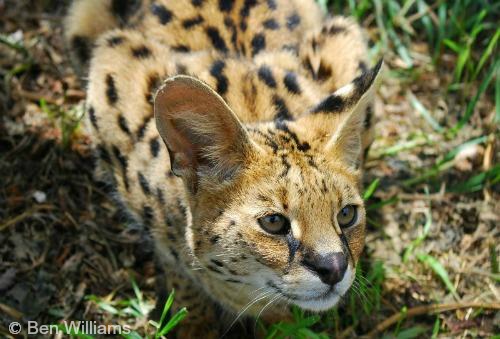- HB Length: 59-92 cm (23-36″)
- Tail Length: 20-38 cm (8-15″)
- Height: 40-65 cm (16-26″)
- Weight: 7-13.5 kg (15-30 lbs)
- Pop. Trend: Stable
The Serval Leptailurus serval is named from a Portuguese word meaning ‘wolf-deer’. The first impression on seeing these cats is one of extremes – elongated neck, very long legs, and very large ears on a small, delicate skull. It is easy to see the ‘deer’ part of the name.
Their coat is pale yellow, with black markings consisting either of large spots that tend to merge into longitudinal stripes on the neck and back, or numerous small spots which give the animal a ‘speckled’ appearance. The underside is whitish grey or yellowish. Their skull is more elongate than most cats, and has a very high sagittal crest. The Serval’s eyes are yellowish, and the pupils contract into a spindle-shape in bright light. There is a dark stripe above and at the corner of the eye. The hind legs are longer than the front ones. In proportion to the rest of their body, Servals have the longest legs in the cat family. The ears are broad based, high on the head and close together, with black backs and a very distinct white spot. The tail is only about one third of the body length, and has six or seven black rings and a black tip.
Another variation with a more buff coloured coat covered with smaller dots is known as a servaline cat. It has been found that the small spotted form occurs in dense vegetation and secondary forests, while the Serval inhabits grasslands and open savannahs. Melanistic (black) animals also occur in the moist areas of their range.
Distribution

The Serval is distributed over 34 African nations. It seems not to be very abundant anywhere and is considered rare in some countries. It is commonly recorded in national parks and reserves but its status outside such protected areas, especially in northern Africa, is not well known. It is assumed that it may be quite common in suitable habitat as it is quite adaptable to altered landscape if enough prey and cover is provided.
In the Ngorongoro Crater in Tanzania its minimum density was estimated to be 0.42 individuals per km², on farmland in South Africa, the number was much lower (0.08 servals per km²) and in Luambe National Park, in Zambia, the density was 0.1 individuals per km².
Both sexes mark and hold their territories. Home ranges overlap considerably, and males mark their territory very frequently, spraying up to 46 times per hour or 41 times per sq. km. Females mark about half as frequently.
Habitat
Optimum habitat for these cats is well-watered, long-grass savannahs, especially those associated with reed beds and other river vegetation. Due to this association with permanent water sources its distribution is localized over a wide area and within a variety of habitats. The Serval does not occur in desert habitats or in the rainforests of Central Africa, but it can penetrate dense forests along waterways and through grassy patches. They seem to be able to adapt to agricultural areas if enough prey, cover and water are available, and are thought to be very tolerant of agricultural development.
Ecology
Servals are usually crepuscular or nocturnal hunters near humans, but may also hunt in the day during the wet season or if feeding a litter. In the heat of the day, they often rest in abandoned aardvark burrows or under a shady bush. They are excellent climbers, and take to the trees in emergencies. They are solitary and territorial and interactions with same-sex individuals appear tolerant.
Unlike the Cheetah Acinonyx jubatus, Servals do not use their long legs for speedy chases. Instead, the legs lift them up on miniature stilts. They are used in the long grass or reeds as the Serval moves along in a series of high antelope-like leaps, from one to four metres in length and up to two metres high. Small animals that break cover are immediately pounced upon. Like the Caracal Caracal caracal that shares much of their range, Servals use vertical leaps to catch birds and insects in the air, using either a ‘clapping’ of the front paws or a downward blow with one or both paws. At night or in dense grass, they rely on sound alone to pinpoint the target. For this, their large ears are especially useful.
Servals use their long, loose digits to hook rodents out of burrows. They have been observed waiting beside the burrows of animals such as mole rats, and when the rat came near the entrance, they hooked it out and flung it high into the air in a single smooth movement. It has been suggested they locate the mole rats by listening to their underground movements. Servals will also deal with captured prey by raining down blow after blow with their front paws. Their prey is stunned or even killed before they risk biting it.
From over 2,000 observations in 1985, it was calculated that Servals were successful in 50% of their pounces. A female with kittens was even more successful (62%). Annually in the Serengeti, each Serval eats about 4,000 rodents, 260 snakes and 130 birds. The number of insects eaten was not estimated but would probably be much higher than all the rest combined.
Reproduction
Social interactions between the sexes are limited to short periods when they travel and rest together, and breeding is seasonal. As the female comes into heat these periods become more frequent and prolonged. After a 67 – 77 day gestation, one to five, usually two or three, kittens are born in an old burrow, rock crevice, or under a thicket, each weighing about 250 grams. Their eyes open in nine to 12 days, and they take their first solid food at three weeks. Independence is achieved at six to eight months. Females take care of the litters on their own; the male does not take any active role. At around 18 – 24 months, the now sexually mature young are chased out of the mother’s home range and forced to disperse. Longevity in the wild is unknown, but they have lived to 23 years in captivity.
Threats
- habitat loss and degradation of wetlands
- illegal fur and skin trade
- predator control programs
- hunted for sport
- hunted as predators on domestic poultry
Conservation
The main threat to these cats is the loss and degradation of wetland habitat mostly caused by increasing urbanization and land use changes. Such wetlands show high rodent densities compared with other environments and are the core areas of serval home ranges. The degradation of grassland habitat through burning and over-grazing by livestock leads to a reduced abundance of small mammals and therefore negatively affects the cat.
Even though international legal trade is declining, some trade in skins is still reported from many countries. Serval furs are often marked as “cheetah” or “leopard” fur. In West Africa, their furs are mainly used for ceremonial or medicinal purposes. Economically, the furs are of high value and they are mostly sold on local markets. The extent of the trade in their skins is not known.
This cat is also killed through indiscriminate predator control methods and it is hunted for sport. They climb on trees when chased by hounds, making them an easier target.
Some African tribes consider their flesh a delicacy. In rural areas throughout Africa, they are persecuted as retaliation for poultry predation. It rarely preys upon livestock, but in South Africa it is hunted for this reason. It could even be considered beneficial to farmers since it preys upon rodents.
One key aspect of Serval status is the conservation of its habitat, especially of wetlands. More surveys and monitoring are needed to get more information about their conservation status and to have a better idea of the impact of hunting activities as well as habitat destruction on its status and distribution.
Range Map IUCN Red List (2008)
Updated 2019


Evan
amazing helped me through my article writing at school
Hannah
thx! i have to research 4 school and this was a great help!!
Modgaji cheetah-walking safari | The Planner
[…] Modgaji, tour the African Wild Cat and Serval conservation projects, or go on game […]
Should Serval Cats Be Housecats? – Why Cats Rule The World
[…] Serval […]
animalsst
[…] serval is found in most parts of Africa, has extraordinarily long legs for its body size which can be up […]